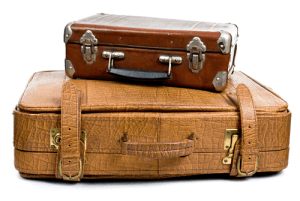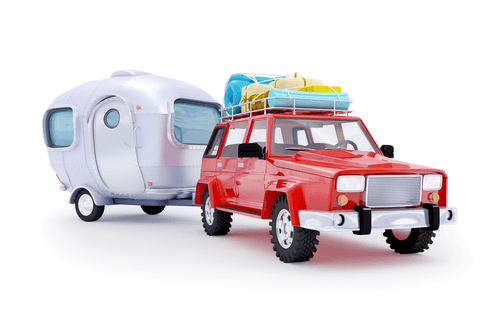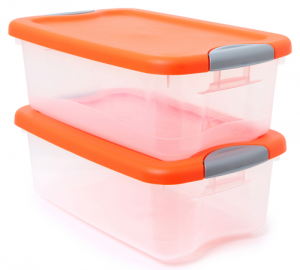No matter how experienced of an RVer you may be, you’re bound to forget something. The smart ones use a checklist so this won’t happen. And then there’s me.
A few summers back on our first camping trip of the season, we were busy setting up camp at Seven Lakes State Park near Holly, Michigan. My job is to get the outside squared away while my wife is busy setting up the inside our hybrid travel trailer.
 No matter how experienced of an RVer you may be, you’re bound to forget something. The smart ones use a checklist so this won’t happen. And then there’s me.
No matter how experienced of an RVer you may be, you’re bound to forget something. The smart ones use a checklist so this won’t happen. And then there’s me.
A few summers back on our first camping trip of the season, we were busy setting up camp at Seven Lakes State Park near Holly, Michigan. My job is to get the outside squared away while my wife is busy setting up the inside our hybrid travel trailer.
“Honey, where are the poles for the beds?”
Gulp. I never put them back in the camper when I de-winterized and cleaned the RV, so had I left them at home. Unable to use our beds, we spent that fist night sharing the dinette bed, bringing new meaning to the term “close-knit family.” We have never forgotten the bed poles again.
That being said, there are two rules to packing for RV Camping Trip:
- Use a checklist so you don’t forget anything.
- Pack your RV so everything’s secure and the weight is distributed evenly.
 Use an RV Camping Checklist
Use an RV Camping Checklist
Using a checklist is absolutely essential. Start with a basic list, and then each time you camp you’ll add or delete from it. We still modify our list to this day (although bed poles now have a permanent spot on our list).
The following is a suggested list. From supplies to food to equipment, your list will be unique to you.
|
|
 Pack with Purpose
Pack with Purpose
When packing items in your RV, you want to make sure they’re secure and that the weight is distributed evenly. If the items aren’t secure, they will bounce around the RV during travel and they very well could break. If the weight isn’t distributed evenly side-to-side and front-to-back, then your RV will be more difficult to control during travel.
Securing items during travel isn’t difficult. It’s simply a matter of making sure everything is stored in such a way that they won’t slide about or otherwise come loose during travel. Pack items tightly together. Use bungee cords, straps and other cords, if need be. Use sleeping bags, pillows and blankets as buffers. We even use our old egg crate pads used on our tent floor for packing things in tightly. Don’t forget about food and other items in the refrigerator. These need to be secured as well. Try to avoid glass bottles as much as possible.
I’ve found that putting items in using clear plastic bins, especially smaller items, is a great way to keep things from ending up all over the RV. One type of plastic bin that has been especially helpful for the underneath pass-through storage areas is the type with wheels underneath, designed to be used as under-bed storage.
As far as balancing the weight, common sense dictates that if you load too much on one side of the RV, your camper will naturally pull to that side during travel. Likewise, if you have too much weight at the front or back of the camper, then your hitch connection will either droop or rise in warning. Make sure you know the maximum cargo capacity of your RV as well; an overloaded RV is a recipe for disaster.
 In an RV, space is at a premium. Decide what is essential, and then explore ways to make those items take up as little space as possible. Examples are collapsible pots and pans, trial- or travel-size toiletries and a multi-bit screwdriver. You not only will be limiting the amount of space your cargo is occupying, but you also will be reducing the amount of weight as well.
In an RV, space is at a premium. Decide what is essential, and then explore ways to make those items take up as little space as possible. Examples are collapsible pots and pans, trial- or travel-size toiletries and a multi-bit screwdriver. You not only will be limiting the amount of space your cargo is occupying, but you also will be reducing the amount of weight as well.
Finally, another packing tip is to bring as little as possible, yet make sure you have what you need if you need it. Do you really need to pack everything on the list above? Probably not. But you also must be prepared. That’s why I have extra power cords and adapters, extra fresh water hoses and extra hitch pins and locks. It’s a delicate balance, but when the only level spot on the campsite means you’re too far from the post, it’s good to know I have extra cords. It’s easy enough to buy marshmallows or some other food you might have forgotten, but those RV-specific items aren’t always easy to come by when on the road.
See you next week when we talk about How to Plan a Meal for your RV Camping Trip.
Rick Kessler
Gr8LakesCamper celebrates the world of RV Camping in the Great Lakes region. Gather around the campfire and share tips, ideas and stories on RVing, camping and travel destinations. Follow Gr8LakesCamper on Twitter, Facebook, Pinterest and the Gr8LakesCamper blog.